Test Triumph Tiger 1200 XRT and XCA 2018: ready for the road adventure
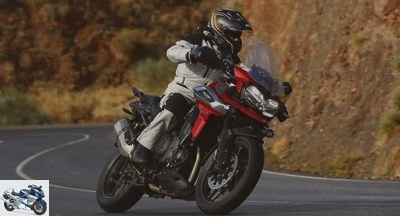
Electric window, keyless start, hill start assistant, directional lights, regulator, 3-cylinder 141 hp. No, this is not the description of a high-end car, but of a motorcycle ! And not just any: the 2018 Tiger 1200 in its fully equipped XRT and XCA versions! Testing.
Tiger 1200 XRT and XCA test – Page 3: Technical point
Engine
No major mechanical change on the Tiger 1200: its engine is still a liquid-cooled 1215cc in-line three-cylinder, with dimensions of 85 x 71.4 mm and compressed to 11: 1. Adjustments to the injection and the The exhaust – lighter and shorter by 40 mm – raises its power from 139 to 141 hp (at 9350 rpm), making it "the most powerful cardan drive motor in its class," says Triumph.
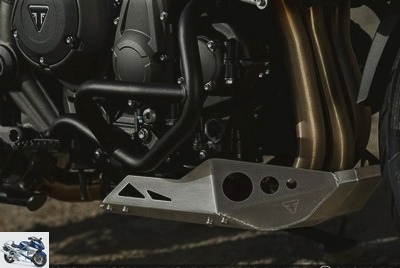
On the other hand, his torque shows a small drop of one unit, caused in part by "suffocation" linked to standards. The three-legged however still delivers 122 Nm at 7600 rpm, or 1 Nm more than its release in 2012, and Triumph ensures that the loss is largely compensated by the smoothing of the torque curve, which makes the engine even more available. Handlebars in hand, it’s convincing: the acceleration is sustained and without any downtime.
Its performance is controlled by an electronic Ride-by-wire accelerator, whose operation has been fine-tuned for smoothness. This cable-free accelerator is linked to several injection maps – via the driving modes – which influence the power distribution, without restricting: the 141 hp are still present, but flow much more gradually and linearly in "Rain" mode "only in" Sport "mode.
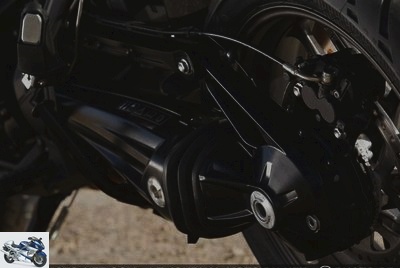
Triumph also took the opportunity to lighten certain parts, including the flywheel which loses 2.5 kg and the camshaft which loses 0.5 kg. This lightening of the moving parts favors the reactivity of the 3-legs on paper, by reducing the motor inertia. In practice, this improvement is hardly noticeable: the engine did not seem particularly lively to us. In addition, the cylinder head covers are now in magnesium (- 0.3 kg), while the battery is reduced by 2.5 kg.
On the high-end versions (XRT with spoke rims and XCA with spokes), this reduction in weight is accentuated by lighter engine guards, fog lights and belly pan. They are also delivered as standard with an Arrow silencer in titanium and with carbon exit, both prettier and lighter (-2.1 kg). The other versions benefit from an exhaust shortened by 40 mm and lighter by 315 gr..
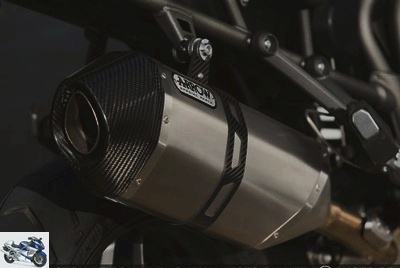
The clutch is coupled to a hydraulic assistant system which reduces lever effort and limits rear wheel blockages (anti-dribble). A bidirectional shifter appears on the XRT and XCA, allowing up and down gears without disengaging. Finally, the service intervals remain fixed at 16,000 km.
Part-cycle
The 2018 Tiger’s frame is unchanged: it is a tubular trellis connected to a rear frame made of welded tubes. The geometrical values change slightly at the level of the front axle, whose caster angle opens from 23.1 to 23.2 ° and the caster goes from 99.2 to 99.9 mm. The wheelbase is identical to 2016 at 1520 mm.
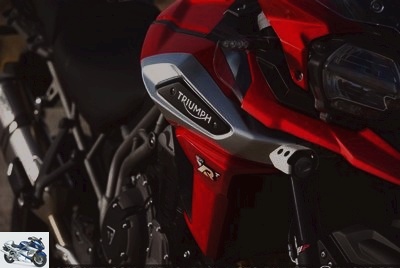
The ergonomics evolve by the means of a handlebars brought closer by 20 mm, while the comfort is improved via a redesigned saddle. Everything else is similar to 2016, starting with the segmentation into two lines: the XR with spoke rims and the XC with spoked wheels. The rims are 120/70/19 and 170/60/17 on all models.
Since 2016, the suspensions are WP, property of the Austrian group – and rival – KTM. They are of the classic type – with mechanical adjustments – on the entry-level XR (spoked wheels) and semi-active on the XRX, XRT, XCX and XCA. At the front, the fork is the beefy type with 48 mm in diameter.
The travel is in phase with the off-road capabilities claimed: 190 mm at the front and 193 mm at the rear. These suspensions also introduce new settings to improve their behavior and adapt to the drop in weight: the Tiger 1200 indeed weighs 2 kg to 10 kg less depending on the version, or 242 kg (dry !! ) for the XR, 243 kg for the XRX and up to 248 kg for the XCX and XCA.
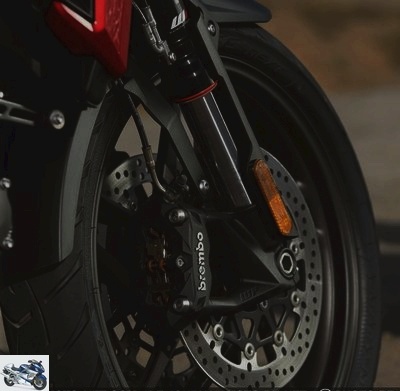
With 20 liters of gasoline in the tank and a few extra fluids, the full weight must therefore oscillate around 270 kg … The Tiger 1200 remains a heavyweight in the maxi-trail category! Also note the renewal of an XRX "Low" version lowered by 45 mm, via a hollow saddle and specific suspensions. Its height varies from 790 to 810 mm (very simple adjustment without tools) against 835 to 855 mm on the other models.
Braking is entrusted to Brembo as in 2016, but new pads are installed on the monobloc calipers with radial mounting. These 4-piston clamps close on 305mm discs (Nissin 2-piston caliper and 282mm disc at the rear). This braking is partially coupled, from the front to the rear.
Electronic
Not a lot of changes, but improvements dictated by progress. The Tiger retains its Ride-by-wire accelerator and driving modes: three on the entry-level XR (Rain, Road and Off Road), four on the XCX and XRX (Rain, Road Sport and Off-Road) and five on the XCA and XRT (Rain, Road, Sport, Off-Road and Rider). These modes also act on the way in which the throttles will open but also on the sensitivity of the ABS and traction control..
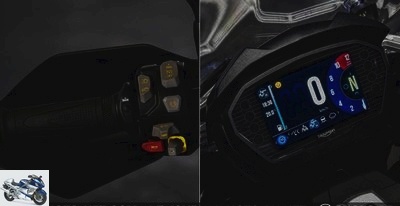
The XCA also releases a new mode: Off Road Pro, with which the anti-skating is totally deactivated and the action of the ABS is done very light on the front (deactivated at the rear). Very efficient off-road, including in the muddy conditions of this test. This did not prevent MNC from lamentably putting the XCA to 1.5 km / h while attacking a hyper slippery slope, fortunately with no other damage than our self-esteem. !
The "M" button located on the left stalk allows you to switch from one to the other while driving: just cut off the throttle and disengage to validate your choice. For safety reasons, certain modes cannot be selected while driving, in particular those where the traction control or the ABS are deactivated. On versions fitted with semi-active suspensions (all except the XR), the choice of mode also influences the damping setting: in "Rain" mode, the WP hydraulics open automatically in order to promote comfort and traction. Conversely in "Sport" mode, the setting of the suspensions is much firmer.
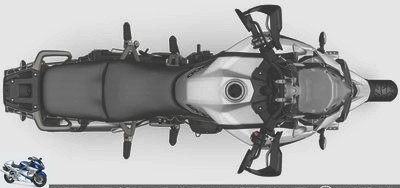
On all models – except the entry-level XR – ABS, traction control and piloted suspensions are provided by an IMU inertia unit. Thanks to a battery of sensors, this "electronic brain" is able to measure the position of the motorcycle in real time along six axes (three in 2016). By crossing these data with other parameters (position of the throttle butterflies, gear engaged, rpm, etc.), the IMU refines the action of the traction control but also of the ABS, now capable of regulate the braking force on the angle. This "cornering ABS" varies the braking power and automatically distributes it from front to back to avoid crossing skis.
In "Off-Road" mode, the rear ABS is cut off when the pedal is operated alone. But if we squeeze the right lever, the front and rear continue to work together. Another particularity of the "Off-road" mode: its specific calibration of semi-active suspensions, logically more flexible.
The semi-active WP suspensions – the software of which is entirely developed by Triumph – automatically adjust the preload according to the weight of the pilot, and of his possible passenger. Their hydraulic laws then change in real time depending on the type of driving, the state of the road and the driving mode engaged. Their effectiveness was already very convincing in 2016, it is still the case two years later..
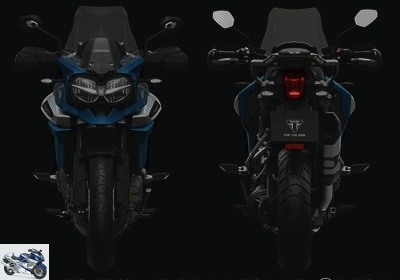
Thanks to a new – and practical – joystick located on the left stalk (below the indicators), it is also possible to "manually" adjust the taring via a dedicated menu, which is in the form of a graduation ranging from Comfort to Sport. Convenient to add a little rigidity to the passage of a ferrule portion.
Adaptive directional lights are also appearing on the top-of-the-range XRT and XCA models: these are rows of diodes placed under the dual optics which light up progressively according to the angle taken by the motorcycle. MNC was unable to test their efficiency due to the lack of night driving.
Finally, the latest development added only on the two "fully equipped" versions (XRT with sticks and XCA with spokes): the Hill Hold control System, a device for assisting hill starts. To activate it, when stationary only, strongly press the front brake as if trying to put it to the stop. An orange "Hill Hold" light comes on on the instrument panel, indicating the system has come into action: the rear caliper is then blocked, preventing any rearward movement but also forward (the system also works downhill).
The rider then only has to concentrate on managing the throttle and the clutch in order to take off smoothly, without fear of seeing the motorcycle backing up… Interesting on the road, but also off-road because this allows the motorbike on a slope !
Related articles
-
2018 Triumph Tiger 800 XCA and XRT test: smart vision Does the imposing Triumph Tiger 1200 intimidate you? Opt for the Tiger 800 2018: more accessible…
-
Tiger Explorer XCA test : Triumph at a crossroads Electric screen, semi-active suspensions, hill start aid, high-tech ABS and anti-skidding: so many…
-
2018 Triumph Tiger 800 XCA and XRT test: smart vision Does the imposing Triumph Tiger 1200 intimidate you? Opt for the 2018 Tiger 800: more accessible…
-
Test Triumph Tiger 1200 XRT and XCA 2018: ready for the road adventure Electric window, keyless start, hill start assistant, directional lights,…
-
2018 BMW F 750 GS and F 850 GS test: which one to choose ? In 2018, the BMW F750GS and F850GS gain in displacement and technology to succeed the F700GS…
-
Test Triumph Tiger 1200 XRT and XCA 2018: ready for the road adventure Electric window, keyless start, hill start assistant, directional lights,…
-
Trail – Triumph Tiger 800 XCx test: Keep calm and ride on – Happiness is in eXCès x?
Triumph Tiger 800 XCx test: Keep calm and ride on After having tested and approved the road and high-end ” XRx ” version of the new Tiger 800 2015,…
-
Trail – Test Tiger Sport 2016: the Triumph of eclecticism – The Tiger Sport more techno, logical?
Tiger Sport 2016 test: the Triumph of eclecticism Are you very much for eclecticism? Triumph yes, since since 2007 the Tiger 1050 combines the heart of a…
-
Trail – Tiger Explorer XCA test: Triumph at the crossroads – Dynamic: the Tiger has its fangs!
Tiger Explorer XCA test: Triumph at a crossroads Electric screen, semi-active suspensions, hill start aid, high-tech ABS and anti- skidding : so many…
-
Triumph Speed Triple R 2016 test: 3 new reasons to crack The 2016 Speed Triple, sexier with its redesigned double optics, better equipped and still…